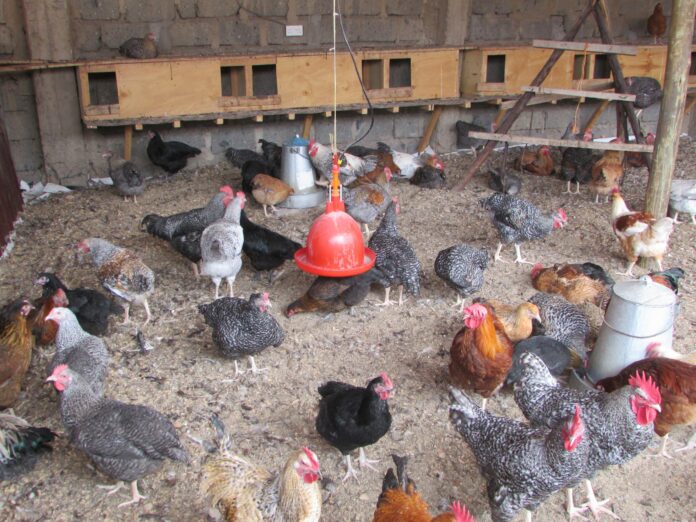Poultry litter is a mixture of droppings, feathers, bedding material, feeds and water in the chicken coop after cleaning.
The nutrient concentration of the litter depends on the type and amount of bedding material, poultry kept, number of birds, the nutrients included in the poultry diet and the age of the chickens. It is advisable to collect this litter once after every two weeks.
Strategies should be used to ensure that it does not get into water courses. Poultry litter is profitable for use either as manure or animal feed since it minimizes cost and maximizes total nutrient input.
While it might appear suitable for direct garden use, domestic poultry litter is generally unsuitable for this purpose. This is because if used fresh, it could burn plant roots, attract vermin and rodents.
Storage
Store the poultry litter well to use it as fertilizer and minimize health and pollution risks. Pile it in an open small stack not more than 1.8m high to reduce loss of nitrogen and organic matter due to overheating.
The site should be well-drained and away from water courses and fenced to keep off livestock.
Compact the base of the stack to reduce chances of coming into contact with surface water. Store the litter for shorter periods, in amounts that meet the needs of the current growing season. This will help maintain the material’s nutrient value and reduce environmental risk and liability.
Composing
Composting may reduce the risk of nutrients from poultry litter entering water courses, thus, cutting the weight and volume of the original material. Composted poultry litter is a more valuable fertilizer than fresh litter. Heap the litter in rows of about 1.2m high and 2.4m wide to achieve temperatures of 60°C to 70°C or simply add a 5cm layer to every 15cm of the other material.
Composting normally increases cost and time required for processing, but reduces the total amount of nitrogen and organic matter available during land application. The composted material can be used in nurseries, gardens and flower farms.
Everything you need to know about making money from passion fruit farming
Uses of poultry manure
Fertilizing all types of pastures: It can be applied to mixed pastures comprising grasses and legumes. Do not graze pastures for at least three weeks after spreading poultry litter to allow regrowth period on a well-grazed paddock.
Application can be done by broadcasting, followed by cultivation into the soil where possible to reduce smell and loss of nitrogen into the air. Do not apply litter on steep land.
Fertilizing fruit crops and vegetables: This can be applied at the rate of 150g per square metre for most crops. Additional potassium fertilizer may be needed. Note that fresh poultry manure is known to harbour pathogens, therefore, it is crucial to mitigate the possibility of vegetable contamination.
This is achieved through the use of composted manure. Incorporate the manure in the soil, and using polyethylene, mulch to cover the soil.
Biogas production: A digester tank of 2,000kg can handle approximately 17 tonnes of chicken litter per day, which would yield 3,400g biogas. You need to dilute with water to remove ammonia, which inhibits anaerobic digestion. It takes about 30 days for complete digestion of chicken litter.
Animal feed production: Poultry litter can be fed to cattle by incorporating into their rations. Litter fed at 40 per cent can cover almost completely the protein and mineral requirements of beef cattle. A significant level of energy and the total required minerals like calcium and phosphorus can be fully met when broiler litter is fed to beef cattle at 20 per cent inclusion level.
Give preference to feeds low in ash such as sugar, cassava and other tubers, cereal grain, and fruit wastes. Fruit wastes are rich in digestible energy and are excellent balancing ingredients for poultry waste.
Supplement with additional energy in the form of molasses and starchy feeds to increase palatability, feed intake and maximum utilisation of the non-protein nitrogen fraction of poultry waste.
You can also ensile litter with forages and high moisture grains like maize. Such silage has higher palatability with better performance than silage containing soybean as protein source.
When handling poultry manure, observe the following precautions:
1). Remove any dead birds and parts of birds like feathers and bones to minimize harm especially when used in livestock feeds.
2). Ensure that the bedding material does not contain chemicals, always wear gloves when handling the litter and avoid using poultry litter from sick birds.








